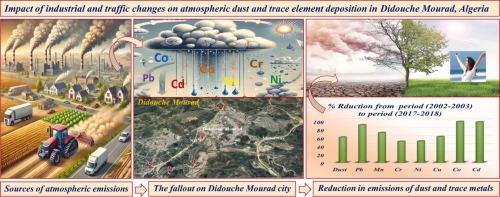阿尔及利亚Didouche Mourad工业和交通变化对大气粉尘和微量元素沉积的影响
IF 11.3
1区 环境科学与生态学
Q1 ENGINEERING, ENVIRONMENTAL
引用次数: 0
摘要
考虑到大气沉降对环境和健康的重要影响,本研究考察了2002年6月21日至2003年6月20日(P1)至2002年8月21日至2003年8月20日(P2)期间阿尔及利亚Didouche Mourad大气粉尘和微量元素沉降的长期变化,这一时期工业和基础设施发生了重大变化。利用一个由10个采样点组成的网络,我们进行了为期两年的测量活动,以量化粉尘和7种微量元素(Pb、Mn、Cr、Ni、Cu、Co和Cd)的沉积速率。我们使用了多种技术,包括时空分析和富集因子计算,来了解局部变化如何影响空气质量。结果表明,两个时期的平均跨站点沉积率显著降低:粉尘(61%)、Co(98%)、Cd(97%)、Pb(90%)、Mn(76%)、Cu(62%)、Ni(51%)和Cr(50%)。这一改善归功于具体的干预措施,包括新建道路和升级工业过滤系统。观测到季节沉积模式的变化,2002-2003年夏季和秋季水平升高,2017-2018年夏季和冬季达到峰值。通过主成分分析确定了每个时期的四个主要污染源:农业活动(P1)、土壤粉尘(P2)、撒哈拉沙尘(P1, P2)、车辆排放(P1)、水泥厂(P2)和工业过程(P1, P2)。这项研究为工业地区空气质量管理战略的长期有效性提供了重要见解,并为在类似的全球环境中评估和减轻大气污染提供了一个模型。本研究的综合方法和延长的时间框架显著有助于我们理解城市-工业环境中大气沉积的复杂动力学。本文章由计算机程序翻译,如有差异,请以英文原文为准。

Impact of industrial and traffic changes on atmospheric dust and trace element deposition in Didouche Mourad, Algeria
Given the critical environmental and health implications of atmospheric deposition, this study examined the long-term variations in atmospheric dust and trace element deposition in Didouche Mourad, Algeria, from 21/6/2002–20/6/2003 (P1) to 21/12/2017–20/12/2018 (P2), a period marked by significant industrial and infrastructural changes. Using a network of 10 sampling sites, we conducted two-year-long measurement campaigns to quantify the deposition rates of dust and seven trace elements (Pb, Mn, Cr, Ni, Cu, Co, and Cd). We used a combination of techniques, including spatiotemporal analysis and enrichment factor calculations, to understand how local changes affect air quality. The results showed a substantial reduction in the average cross-site deposition rates between the two periods: dust (61 %), Co (98 %), Cd (97 %), Pb (90 %), Mn (76 %), Cu (62 %), Ni (51 %), and Cr (50 %). This improvement was attributed to specific interventions, including new road construction and upgraded industrial filtration systems. Shifts in seasonal deposition patterns were observed, with elevated levels in summer and autumn during 2002–2003, changing to peaks in summer and winter in 2017–2018. Four main pollution sources were identified through PCA for each period: agricultural activity (P1), soil dust (P2), Saharan dust (P1, P2), vehicular emissions (P1), cement plant (P2), and industrial processes (P1, P2). This study provides crucial insights into the long-term effectiveness of air quality management strategies in industrial areas and offers a model for assessing and mitigating atmospheric pollution in similar global settings. The comprehensive approach and extended timeframe of this study significantly contribute to our understanding of the complex dynamics of atmospheric deposition in evolving urban-industrial environments.
求助全文
通过发布文献求助,成功后即可免费获取论文全文。
去求助
来源期刊

Journal of Hazardous Materials
工程技术-工程:环境
CiteScore
25.40
自引率
5.90%
发文量
3059
审稿时长
58 days
期刊介绍:
The Journal of Hazardous Materials serves as a global platform for promoting cutting-edge research in the field of Environmental Science and Engineering. Our publication features a wide range of articles, including full-length research papers, review articles, and perspectives, with the aim of enhancing our understanding of the dangers and risks associated with various materials concerning public health and the environment. It is important to note that the term "environmental contaminants" refers specifically to substances that pose hazardous effects through contamination, while excluding those that do not have such impacts on the environment or human health. Moreover, we emphasize the distinction between wastes and hazardous materials in order to provide further clarity on the scope of the journal. We have a keen interest in exploring specific compounds and microbial agents that have adverse effects on the environment.
 求助内容:
求助内容: 应助结果提醒方式:
应助结果提醒方式:


